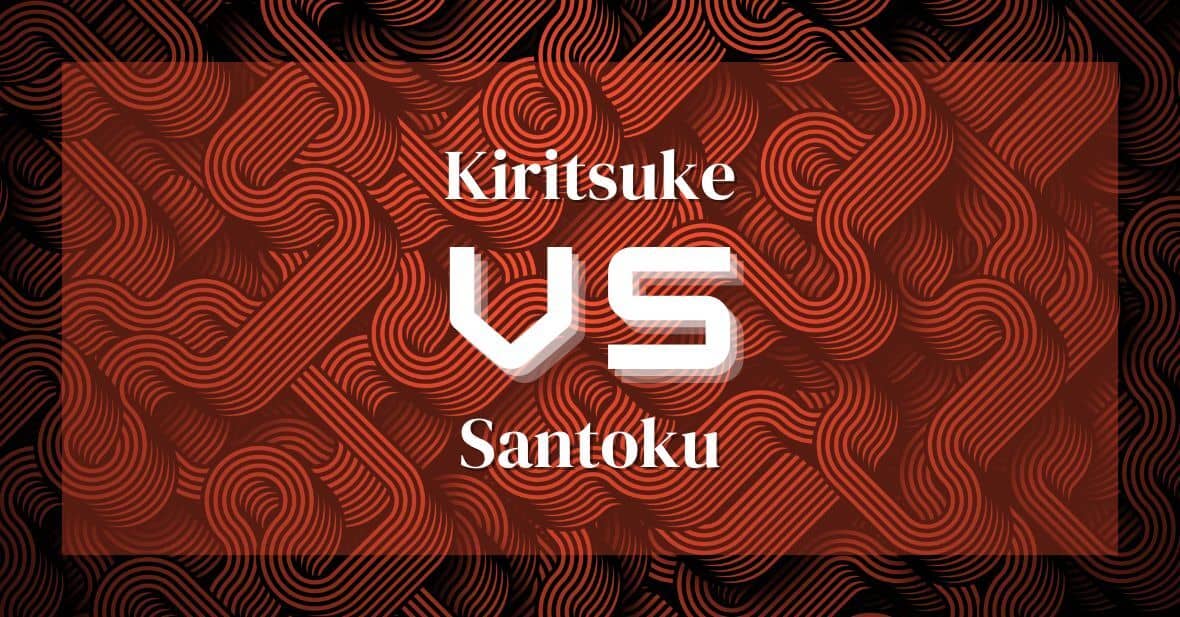Kiritsuke vs Santoku: Unveiling the Japanese Knife Masterpieces
Have you ever looked at two kitchen knives and wondered what the difference was between them? Whether it’s a kiritsuke or santoku, you’ll be surprised to learn that they have both similarities and differences.
Let’s take a closer look at this perplexing situation! With a little bit of humor sprinkled in for good measure, we’ll explore how these two Japanese knives are similar yet dissimilar.
Get ready for an entertaining journey as we uncover the mysteries of the kiritsuke and santoku knives!
Anatomy of the Kiritsuke
The kiritsuke is a versatile knife, but what sets it apart from other knives? Let’s take a closer look at the anatomy of this special tool.
The blade of a kiritsuke is typically longer than that of a santoku and features a flat edge profile with an acute tip. This makes it perfect for slicing and chopping tasks, since its sharp tip helps to make precise cuts while its flat edge provides greater balance than other types of blades.
Additionally, the balance point on the kiritsuke is further back than traditional Japanese knives, which makes it easier to use for extended periods of time without tiring out your wrist or arm.
All in all, the unique blade shape and enhanced balance make the kiritsuke an ideal choice for many cutting tasks – making it stand out from its counterparts!
Anatomy of the Santoku
The santoku knife is unbelievably versatile and can handle almost any kitchen task with ease. Its blade is shorter than that of a traditional chef’s knife, making it ideal for those who lack the strength for larger knives.
It has a flat edge and usually comes with a granton edge which creates air pockets between the food and the blade when slicing, making it easier to cut. Here are three features that make this knife so special:
- A flatter edge compared to other knives in its class – great for chopping vegetables in one go!
- Granton grooves on the blade – reducing friction when you cut through tough items like meat or fish.
- A comfortable handle – ensuring your grip stays steady even after long hours of chopping ingredients.
Knife care and proper cutting techniques are essential when using this type of knife since its thinner blade can be prone to chipping if not treated correctly. To maximize its potential, use wooden boards as a cutting surface instead of metal ones – this helps protect against damage from sharpening stones or steel rods used during honing.
Additionally, always remember to sharpen your santoku regularly and avoid contact with acidic foods as they may corrode the blade over time.
Similarities Between the Kiritsuke and Santoku
Discover how a kiritsuke knife differs from a santoku knife and learn which one might be the best fit for you! The two knives may look similar, but there are some key differences between them. One major difference is that the kiritsuke has a single-edged blade while the santoku has a double-edged blade.
This makes the kiritsuke better suited for more delicate cutting techniques such as slicing fish and vegetables, while the santoku is better able to handle tougher tasks such as chopping meat. Additionally, both knives require different levels of maintenance.
The kiritsuke’s single-edge requires more frequent sharpening than the double-edged santoku. But on the other hand, it can also be easier to maintain since its edges don’t dull as quickly as those of the santoku.
So whether you’re looking for an all purpose kitchen knife or something more specialized, you’ll want to consider these similarities and differences between a kiritsuke and santoku before making your decision! With just a bit of knowledge about their anatomy and maintenance tips in mind, you can easily find your perfect fit!
Differences Between the Kiritsuke and Santoku
With its single-edged blade, the kiritsuke offers more delicate cutting techniques while the santoku’s double-edged design is better suited for tougher tasks.
The difference in blade design between these two knives also affects their handle shapes. The kiritsuke typically has a longer handle, allowing for a more comfortable grip when using precise cuts.
On the other hand, the santoku usually has an ergonomic handle that ensures a secure and tight hold due to its thicker shape. This makes it easier to break through harder foods like dense vegetables or frozen items.
In addition, both knives are available in various sizes so you can choose one that best suits your cooking needs!
Uses of the Kiritsuke and Santoku
You’ll be amazed at the versatility these two knives offer for your culinary needs!
The santoku knife is a versatile kitchen tool perfect for preparing fish and filleting vegetables. Its blade is shorter than that of the kiritsuke, but also wider and the tip is rounded off, making it great for quickly chopping food.
On the other hand, the kiritsuke knife has a longer and narrower blade with squared-off tips which makes it ideal for slicing vegetables thinly. It can also be used to prepare fish by cutting through small bones and trimming away fins.
Both knives are incredibly sharp tools that make meal preparation quick and easy! So regardless of what kind of cuisine you plan on creating in your kitchen, having a kiritsuke or santoku knife will come in handy.
Conclusion
You can’t go wrong with either a kiritsuke or santoku. They both have their advantages and disadvantages, but they’re amazing all-purpose knives for any kitchen.
The differences between the two might seem minor, but they’re actually quite huge! You won’t believe how much easier it makes cooking to have a kiritsuke or santoku in your hands!
These knives make slicing, dicing and chopping effortless, so you can cook like a pro in no time. So don’t wait another minute – get yourself one of these incredible knives today and start cooking up some delicious meals!
Frequently Asked Questions
What Is The Best Way To Sharpen A Kiritsuke Or Santoku Knife?
You’ve got a knife, but do you know the best way to get it sharp? Sharpening stones, honing rods, and knife oils can all help you achieve a razor blade-like finish. These tools also help extend the life of your knives. Regular use of synthetic handles can lead to less overall maintenance, but wood handles are a great alternative too!
Keeping your knives on magnetic strips or in butcher blocks is another way to ensure they stay as sharp as possible. When it comes to cutting boards, plastic and bamboo are better than most other materials for keeping your blades sharper for longer.
As attractive as dishwashers may be, handwashing is actually the best way to keep your kiritsuke or santoku knives in top shape.
What Is The Ideal Handle Material For A Kiritsuke Or Santoku Knife?
When it comes to choosing the ideal handle material for a knife, you have two options: wooden or plastic.
Wooden handles provide a classic look and feel that many people prefer, while plastic handles are generally more durable and resistant to water damage.
If you’re looking for an elegant touch, wooden is the way to go. If durability is your priority, then plastic is probably best.
Ultimately, there’s no wrong answer – it all depends on what works best for you!
What Is The Best Way To Store A Kiritsuke Or Santoku Knife?
Storing your knives safely is an essential part of knife maintenance. Did you know that almost 90% of kitchen knives are improperly stored?
To ensure the longevity and quality of your kiritsuke or santoku knife, it’s important to store them properly. The best way to do this is by using a magnetic strip or wall-mounted rack. This will keep your blades off countertops and out of drawers, which can dull their edges from rubbing against other utensils.
When transporting your knives, wrap them in a cloth or a protective sheath to avoid injury and ensure they stay sharp. With these simple tips, you can make sure your kiritsuke or santoku knife stays sharp for years to come!
What Is The Best Cutting Board Material To Use With A Kiritsuke Or Santoku Knife?
You may not think much about your cutting board when you’re slicing and dicing, but it actually plays a big role in maintaining the sharpness of your knife. Choosing the right material is key to achieving a balanced cut and keeping your knife in optimal condition.
When it comes to kiritsuke or santoku knives, you should look for a wooden cutting board that has been treated with mineral oil to prevent moisture from warping the wood. Not only does this make for an attractive kitchen accessory, but it also helps maintain the balance of your knife – so no more uneven slices!
What Is The Best Way To Clean A Kiritsuke Or Santoku Knife?
Cleaning your knives can be hard work, but it doesn’t have to be! The best way to clean a kiritsuke or santoku knife is by hand. Use warm water and mild detergent. If necessary, use cleaning materials like a soft brush for tough stuck-on food.
Don’t forget to sharpen the blade occasionally too. This will help keep your knife in top shape over time. And don’t worry – taking care of your knives isn’t as daunting as it seems. With just a few simple steps, you’ll have them looking brand new in no time!

